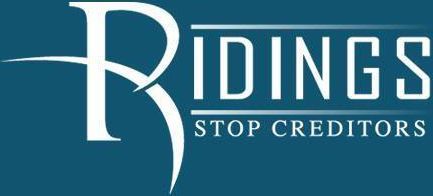Get Debt Relief Through Chapter 13 Bankruptcy in St. Louis
Many hard-working people get into financial difficulty through no fault of their own. A job layoff, a divorce, an accident or other events can cause you to accumulate too much debt or maybe just set you back temporarily. That is why at the Ridings Law Firm in St. Louis, we are here to help eliminate your debt with a Chapter 13 Bankruptcy Filing.
How Chapter 13 is Different Than Chapter 7 Bankruptcy
In a Chapter 13 bankruptcy, some of your debts are reduced or eliminated. We prepare a payment plan which allows you to pay off your remaining debts over a three to five-year period at a rate you can reasonably afford. You can keep your house, your vehicles, and most or all of your personal property. At the end of the payment period, your unpaid debts are discharged. The Chapter 13 does not remain on your credit report as long as a Chapter 7.
Why Choose Chapter 13 Over Chapter 7?
Chapter 13 bankruptcy is generally used by debtors who want to keep secured assets, such as a home or car, especially when they have more equity in these assets than can be protected with their state’s bankruptcy exemptions. This is because Chapter 13 is a reorganization type of bankruptcy, allowing you to restructure your debts and create a manageable payment plan. In contrast, Chapter 7 bankruptcy is a liquidation process where your non-exempt assets are sold to pay off creditors.
Key Differences:
- Asset Retention: Chapter 13 allows you to keep secured assets with significant equity.
- Debt Repayment: A structured payment plan is created for a period of three to five years.
- Credit Report: Chapter 13 affects your credit report for a shorter duration compared to Chapter 7.
Choosing Chapter 13 can be preferable if you have valuable assets you want to retain while still working towards financial stability.
How Does Chapter 13 Bankruptcy Help Prevent a House Foreclosure?
Chapter 13 bankruptcy can be a lifeline for homeowners facing foreclosure. This bankruptcy option allows you to keep your home by developing a plan to catch up on missed mortgage payments over a specified period.
Reorganizing Debt
Instead of liquidating assets, Chapter 13 focuses on reorganizing your debt. This approach enables you to create a manageable repayment plan, typically spanning three to five years. During this time, you can gradually pay off the arrears while maintaining regular monthly mortgage payments.
Stopping Foreclosure Proceedings
One of the immediate benefits is the automatic stay, which goes into effect as soon as you file for Chapter 13. This halts foreclosure proceedings, providing you with temporary relief and the opportunity to get your finances in order without the imminent threat of losing your home.
Protecting Equity
Chapter 13 can also be beneficial if you have significant equity in your home. By catching up on overdue payments through the repayment plan, you can protect this equity. Unlike Chapter 7 bankruptcy, Chapter 13 enables you to retain secured assets provided you adhere to the repayment terms.
Extended Repayment Terms
The repayment plan under Chapter 13 allows you to spread out your overdue payments over time. This extended period makes it easier to manage your debts without overwhelming your financial resources.
By leveraging these components of Chapter 13, many homeowners can avert foreclosure and achieve a more stable financial footing.
How Chapter 13 Bankruptcy Helps with Overdue Payments and Original Agreements
Chapter 13 bankruptcy offers a structured plan to manage your financial difficulties. Here’s how it works:
- Repayment Plan: Under Chapter 13, you can create a repayment plan that spans three to five years. This lets you catch up on overdue payments gradually rather than all at once.
- Debt Restructuring: By reorganizing your debts, Chapter 13 allows you to manage them in a way that fits your financial situation. This means you can handle overdue mortgage or car payments without losing your property.
- Reinstatement of Agreements: Once you begin making the agreed-upon payments under your Chapter 13 plan, you can reinstate the terms of your original agreements. This could mean keeping your home out of foreclosure or your car from being repossessed.
In essence, Chapter 13 provides a practical solution for getting back on track with your financial obligations.
How Much Must Be Paid to Creditors Under a Chapter 13 Plan Compared to Chapter 7 Bankruptcy?
In a Chapter 13 bankruptcy, the amount you pay to creditors must be at least equal to the amount they would receive if you had filed for Chapter 7 bankruptcy.
Chapter 7 bankruptcy typically involves liquidating your non-exempt assets to pay off creditors. Conversely, Chapter 13 doesn't require asset liquidation but mandates a repayment plan based on your income.
Your Chapter 13 plan must ensure creditors receive no less than what they would have gotten through Chapter 7 liquidation. This is often determined by valuing your non-exempt assets.
Key Points to Remember:
- Asset Valuation: Ensure that creditors get at least what they would through Chapter 7.
- Repayment Plan: Based on income, not asset liquidation.
- Equal Payment: The total amount paid must match or exceed Chapter 7 benchmarks.
Understanding these fundamental differences will help you navigate the bankruptcy process more effectively.
Can Chapter 13 Bankruptcy Help with Missed Car or Mortgage Payments?
Yes, Chapter 13 bankruptcy can be a valuable tool for managing missed car or mortgage payments. Here's how it works:
- Prevent Foreclosure: By filing for Chapter 13, you can halt an impending home foreclosure. This legal protection allows you to keep your home while you catch up on late mortgage payments.
- Repayment Plan: Chapter 13 sets up a structured repayment plan that typically spans three to five years. This plan gives you the opportunity to spread out your missed payments over time without the constant threat of repossession or foreclosure.
- Immediate Relief: As soon as you file, an automatic stay goes into effect, which prevents creditors from taking action against you. This means no more harassing phone calls or letters demanding payment for your car or mortgage arrears.
- Keep Your Assets: Unlike Chapter 7, which might require you to liquidate assets, Chapter 13 allows you to keep your property. This is especially critical for individuals who are late on payments but have significant equity in their homes or valuable vehicles.
Chapter 13 offers a practical way to get back on track with missed payments while protecting your valuable assets.
How is the Amount to be Repaid in Chapter 13 Bankruptcy Determined?
The repayment amount in a Chapter 13 bankruptcy is influenced by multiple factors, primarily centered around the debtor’s financial situation.
First, disposable income plays a crucial role. This is calculated through the Means Test, which assesses your income against necessary living expenses to determine how much money you have available to pay creditors.
Additionally, the total amount to be repaid is guided by the requirement that creditors must receive at least as much as they would if a Chapter 7 bankruptcy had been filed. This ensures that the repayment plan is fair and meets minimum legal standards.
Here's a breakdown of the key factors:
- Disposable Income: After essential living expenses, how much money can you feasibly put towards your debt?
- Means Test: This standardized test is crucial in determining your disposable income.
- Comparison to Chapter 7: The plan must offer creditors at least what they’d receive if you filed for Chapter 7.
Important Considerations
- Priority Debts: Certain debts like taxes or child support must be paid in full.
- Secured Debts: Repayment plans may include provisions for catching up on secured debts like mortgages or car loans.
- Length of Plan: Typically, Chapter 13 plans span three to five years, affecting the total repayment amount.
Understanding these factors can help you grasp how your repayment plan will be formulated and ensure you are prepared for the financial commitments ahead.
What Happens to Remaining Dischargeable Debt at the End of a Chapter 13 Repayment Plan?
At the conclusion of a Chapter 13 repayment plan, which generally spans three to five years, something quite beneficial occurs. If you've adhered to the terms of your repayment agreement throughout this period, any remaining eligible debt is essentially wiped clean. This means that the specific debts covered under your Chapter 13 plan—known as dischargeable debts—are forgiven, providing you with a fresh financial start.
Key Points to Remember:
- Adherence to Agreement: It's crucial to stick to your repayment schedule and terms.
- Time Frame: The typical duration is three to five years.
- Debt Forgiveness: At the end of the plan, remaining dischargeable debts are erased.
This process can alleviate a significant portion of your financial burden, offering a viable pathway to fiscal recovery.
How Chapter 13 Bankruptcy Assists in Paying Back Taxes
Chapter 13 bankruptcy offers a structured and effective way to manage and pay back taxes. Here's how it works:
- Stops Accrual of Interest: Once you file for Chapter 13 bankruptcy, interest on your tax debt stops accruing. This can significantly reduce the overall amount you owe over time.
- Repayment Plan: You'll establish a repayment plan, typically spanning three to five years. This plan prioritizes your debt and allocates your payments efficiently.
- Prevention of Tax Liens: Filing for Chapter 13 can prevent the Internal Revenue Service (IRS) from placing liens on your assets, ensuring your property remains protected.
- Priority Treatment: Tax debts are treated as a priority, meaning they are paid off before other debts like credit cards or medical bills.
- Protection from Collections: As long as you're under Chapter 13, collection activities are halted. This includes wage garnishments and levies, offering you peace of mind as you manage your finances.
By leveraging these benefits, Chapter 13 bankruptcy provides a manageable pathway for paying back taxes and regaining financial stability.
What is the Missouri Means Test?
The Missouri Means Test is a method used to determine eligibility for filing under Chapter 7 bankruptcy. It calculates the debtor's disposable income to decide if they have enough funds to repay debts. Here's a breakdown of how it works:
Key Factors in the Missouri Means Test
- Income Evaluation: The test first examines the debtor's average monthly income over the past six months.
- Income Threshold: This income is then compared to the median income for a similar household in Missouri.
- Disposable Income Calculation: If the income is above the median, further calculations are made to determine disposable income by deducting allowable expenses.
Steps Involved:
- Gather Income Data: Collect all sources of income for the past six months.
- Compare with Median Income: Check if your income is lower or higher than the state's median.
- Calculate Expenses: Subtract necessary living expenses and payments for secured debts.
If your disposable income is below a certain threshold, you pass the test, qualifying for Chapter 7 bankruptcy. Otherwise, you might need to file under Chapter 13, where a repayment plan is designed according to your financial capacity.
Conclusion
By assessing income and expenses, the Missouri Means Test ensures that only those who genuinely cannot repay their debts are eligible for Chapter 7 bankruptcy, providing a fair system for both debtors and creditors.
Does Chapter 13 Bankruptcy Stop Interest from Accruing on Tax Debt?
Yes, filing for Chapter 13 bankruptcy can halt the accrual of interest on certain types of tax debt. When you file for Chapter 13, an automatic stay is put in place, which immediately stops most collection actions against you. This includes halting the accumulation of interest on tax debts that are prioritized in the bankruptcy plan.
Here's how it works:
- Automatic Stay: Once you file, the court issues an automatic stay, which stops creditors from pursuing collections, including interest on eligible tax debts.
- Repayment Plan: Under Chapter 13, you propose a repayment plan to pay off your debts over a period of three to five years. During this time, the interest on certain tax debts may be frozen as you make regular payments.
- Priority Debts: Taxes that are considered priority debts—usually those incurred within the last three years—may qualify to have accruing interest and penalties halted.
However, it's important to note that not all tax debts qualify. Some older tax debts, or those deemed non-priority, may continue to accrue interest even during the bankruptcy process.
Filing for Chapter 13 provides a structured way to manage your debts, and stopping interest accumulation on certain tax debts can significantly ease your financial burden. Always consult with a bankruptcy attorney to understand how your specific tax debts will be treated under your repayment plan.
When is Chapter 13 a Better Option?
Chapter 13 bankruptcy is generally used by debtors who want to keep secured assets, such as a home or car, particularly when they have more equity in these secured assets than they can protect with bankruptcy exemptions. If you have valuable nonexempt property that you want to retain, Chapter 13 may be a better option for you.
Chapter 13 allows you to make up overdue payments over time and reinstate the original agreement, which can be crucial if you have fallen behind but wish to keep your secured assets. This reorganization aspect contrasts sharply with Chapter 7, which is a liquidation process.
What Are Missouri Bankruptcy Exemptions?
When you file for bankruptcy in Missouri, you're allowed to keep certain types of property. These are known as exemptions. They help ensure that you don't lose everything and can maintain a basic standard of living. Here's a quick rundown:
Types of Property You Can Keep
- Homestead Exemption: This allows you to protect equity in your home.
- Personal Property: Items like clothing, household goods, and certain electronics fall under this category.
- Vehicle Exemption: You can usually keep one car up to a certain value.
- Wages and Income: A portion of your wages and earnings may be exempt from being seized.
- Tools of Trade: If you rely on specific tools or equipment for your job, those can be protected.
- Public Benefits: Social Security, disability, and veterans' benefits are often exempt.
- Pension and Retirement Accounts: Most retirement savings are protected.
Key Points to Remember
- Missouri has specific dollar limits on each type of exemption.
- You can't double the exemptions if you're married and filing jointly.
- Federal exemptions are an alternative, but you can't mix and match between state and federal.
How to Use Exemptions
Navigating exemptions effectively can mean the difference between keeping and losing key assets. Understanding and correctly applying these exemptions can significantly impact your financial stability post-bankruptcy.
For detailed information, consulting with a local bankruptcy attorney is often a good idea. This ensures you fully understand how to leverage these exemptions to your benefit.
Who is an Ideal Client for a Chapter 13 Bankruptcy Filing?
“A Chapter 13 bankruptcy is ideal for people who have certain types of secured debts, above average incomes, or have property they might otherwise risk losing in a Chapter 7.”
To be eligible for Chapter 13 bankruptcy, you must have a regular source of income and some disposable income to apply towards your Chapter 13 payment plan. This means that individuals considering Chapter 13 should be able to demonstrate consistent earnings that can cover basic living expenses while still contributing to their repayment plan.
Key Eligibility Criteria:
- Regular Source of Income: Steady employment or other reliable income streams.
- Disposable Income: Sufficient funds remaining after necessary expenses to make payments under the plan.
By meeting these criteria, you can leverage Chapter 13 to manage secured debts and protect valuable property. This option is particularly beneficial for those with above-average incomes or assets that could be at risk in a Chapter 7 filing.
Exploring Alternatives to Bankruptcy
Considering bankruptcy might feel overwhelming, but there are other viable paths to financial recovery. Here are some popular alternatives:
Debt Consolidation
Debt consolidation involves combining multiple debts into a single, easier-to-manage payment. This can simplify your financial obligations and potentially lower your interest rates. There are a few methods to achieve debt consolidation:
- Personal Loans: Many financial institutions offer personal loans specifically for debt consolidation. These loans typically come with fixed interest rates and terms.
- Balance Transfer Credit Cards: Some credit cards allow you to transfer balances from other cards to one with 0% interest for a promotional period. Be cautious of fees and plan to pay off the balance before the regular interest rate kicks in.
- Home Equity Loans: If you own a home, you might be able to use its equity to secure a loan. This provides a substantial amount for consolidating debt but also puts your home at risk if you're unable to repay.
Credit Counseling
Credit counseling services can offer support and guidance on managing your debts. These services are typically provided by non-profit organizations and come with personalized financial advice. Here’s what you can expect from credit counseling:
- Budget Review: A credit counselor will analyze your income and expenses to create a realistic budget that helps manage your debts.
- Debt Management Plans (DMPs): If your situation is complex, a counselor might suggest a DMP. Here, you make a single monthly payment to the counseling agency, which then distributes the funds to your creditors. This can often result in lower interest rates and waived fees.
- Financial Education: Credit counseling agencies often provide workshops or resources to improve your financial literacy and help you avoid future debt problems.
By exploring these alternatives, you can find a solution tailored to your financial situation without the long-term consequences of bankruptcy. Each path has its pros and cons, so it’s crucial to research and perhaps consult with a financial advisor to determine the best strategy for you.
Differences Between the Eastern and Western District Courts in Missouri for Bankruptcy Cases
Understanding the distinctions between the Eastern and Western District Courts in Missouri is crucial for anyone navigating bankruptcy cases within the state. Here are the key differences to consider:
Geographical Jurisdictions
- Eastern District Court: This court serves the eastern portion of Missouri, including major cities like St. Louis. If you reside or have a business in this area, your case will be handled here.
- Western District Court: Covers the western region of Missouri, with locations in cities such as Kansas City and Springfield. Residents and businesses within these areas will file their cases in this district.
Court Locations and Facilities
- Eastern District Court: Main courthouses are located in St. Louis and Cape Girardeau. This district may have more streamlined operations due to its centralized locations.
- Western District Court: Offers facilities in Kansas City, Jefferson City, and Springfield. This wider distribution of courthouses may provide more convenience depending on your specific location within the district.
Case Volume and Processing Times
- Eastern District Court: Tends to handle a higher volume of bankruptcy cases because of its larger urban population centers. This could potentially mean longer processing times.
- Western District Court: Might experience lower case volumes, potentially leading to quicker resolutions for bankruptcy proceedings.
Differences in Judicial Procedures
- Eastern District Court: May have unique local rules and procedures specific to bankruptcy cases, influenced by the needs and logistical considerations of the eastern region.
- Western District Court: Similarly, this court may implement different procedural nuances to cater to the western region’s requirements.
Understanding these differences can greatly assist in navigating the nuances of filing for bankruptcy in Missouri. Always consult with a legal professional to get advice tailored to your specific situation.
Understanding Pre-Bankruptcy Credit Counseling and Debt Education Courses in Missouri
Before filing for bankruptcy in Missouri, individuals are required to complete two essential educational courses:
- Pre-Bankruptcy Credit Counseling
- Post-Filing Debtor Education
Both courses aim to help you navigate financial challenges and build a foundation for a more stable economic future.
Pre-Bankruptcy Credit Counseling
This mandatory course must be completed before you file for bankruptcy. It involves a thorough review of your financial situation and provides you with alternatives to bankruptcy. The course usually covers:
- Budget Analysis: Understanding your income and expenses.
- Debt Management: Exploring options for managing and reducing your debt.
- Financial Empowerment: Learning skills to sustain financial health
Approved providers, such as GreenPath Financial Wellness, Money Management International, and Clearpoint Credit Counseling Solutions, offer these courses online, over the phone, or in person.
Post-Filing Debtor Education
After filing for bankruptcy, completing a debtor education course is essential for the discharge of your debts. This course focuses on:
- Personal Financial Management: Integrating effective money management practices into your daily life.
- Saving for the Future: Planning for long-term financial stability and emergency funds.
- Credit Use: Understanding how to use credit wisely and avoid falling into debt traps again.
Providers approved for this course include agencies such as the National Foundation for Credit Counseling (NFCC) and DebtorCC, Inc.
How to Enroll
You can easily enroll in these courses through the websites of the accredited agencies. Often, courses are available in various formats to suit your convenience—whether online, by phone, or in person. Fees vary, but they are generally affordable. Fee waivers may be available for those who qualify based on their income.
By completing these courses through approved providers, you meet the legal requirements and gain invaluable knowledge to help rebuild your financial life post-bankruptcy.
For a comprehensive list of approved agencies, visit the U.S. Trustee Program’s website or consult your bankruptcy attorney.
Final Thoughts
Understanding and completing these educational requirements is a crucial step in the bankruptcy process. They not only comply with legal standards but also equip you with the tools necessary for moving forward with confidence and financial literacy.




